After retiring from a successful diplomatic career in 1966, Sir John Richmond (1909-90) and his wife Diana (1914-97) settled in Durham, where he had accepted a lectureship in Modern Near East History at the University’s School of Oriental Studies. Following the Six-Day War in June 1967, the Richmonds became increasingly concerned at the suffering of Palestinians living in the occupied territories and the strong media bias prevalent at that time. They were instrumental in founding the Council for the Advancement of Arab-British Understanding (CAABU) – along with Michael Adams – and over the next few years devoted themselves to campaigning on behalf of Palestinians.
The extent of this work is evident from the Richmond papers deposited at the University of Exeter’s Special Collections Department, which have now been catalogued and are available for researchers. There are 38 boxes of papers, including correspondence with authors, editors, journalists, diplomats, scholars and activists, folders of press-cuttings, periodicals and pamphlets from the 1920s through to the 1980s, CAABU reports, minutes and newsletters, as well as a wealth of religious ephemera relating to the Richmonds’ work with the CAABU Religious Affairs Group (CRAG) and their interest in inter-religious dialogue. They were both converts to Roman Catholicism and monitored carefully the coverage of Middle Eastern topics – especially the situation in Palestine – in the Catholic press.
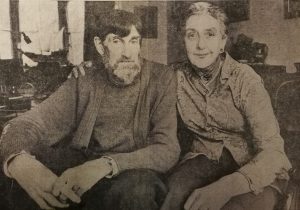
Sir John and Lady Diana Richmond at their home in Durham, from a 1979 newspaper article that reported on how ‘Palestine dominated their life’.
The Richmonds’ love for Palestine, as well their attitude towards the Israeli settlement there, owed much to the life and work of Sir John’s father, eminent architect Ernest Tatham Richmond (1874-1955), who had first gone out to the region in 1895 to help prepare illustrations of an ancient temple. An Arabic speaker, he was entrusted with restoration work on Cairo’s mosques and other commissions in both Egypt and Palestine, and at the end of the First World War he obtained an appointment in the British Mandatory Government in Palestine. Although he resigned in 1924 due to his unease about the strongly pro-Zionist policy of his colleagues, Ernest Richmond returned to returned to Jerusalem in 1927 to take up a strictly non-political appointment as Director of the Department of Antiquities, which he held for the next ten years. Among the Richmond papers are several pamphlets and offprints of Ernest Richmond’s scholarly work, and he was referred to frequently in the correspondence and writings of both Sir John and Lady Diana Richmond.
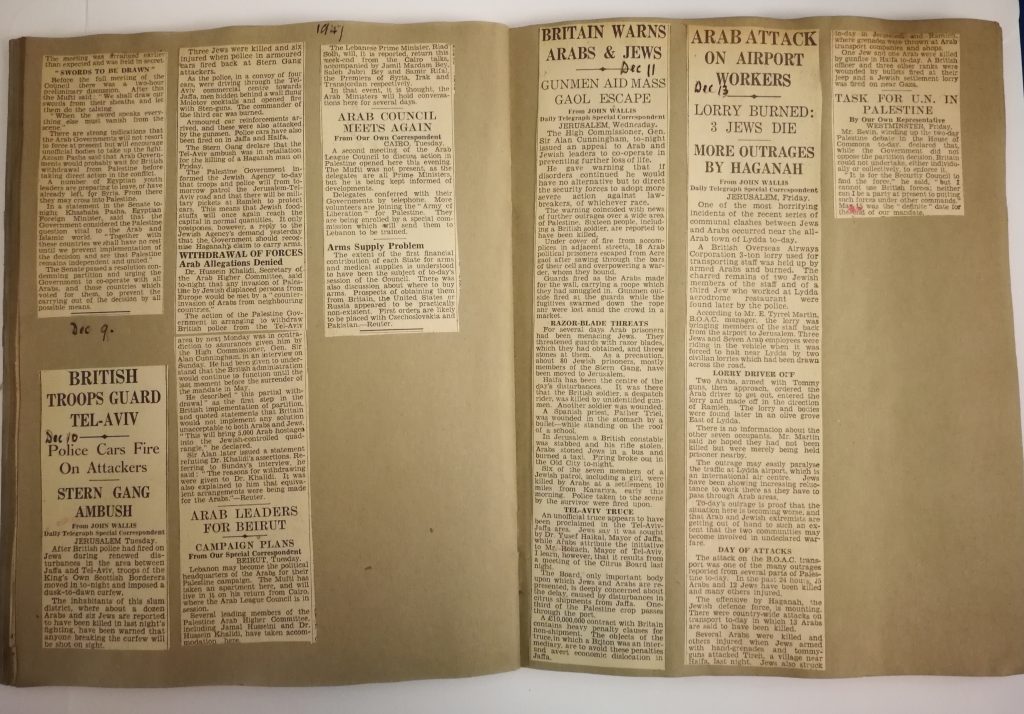
Scrapbook of presscuttings compiled by E.T. Richmond : ‘Palestine, December 1947: some newspaper cuttings describing the events that immediately followed UNO’s decision to partition the country.’ EUL MS 115/25
His son John first visited Palestine as a schoolboy in 1923 and duly followed in his father’s footsteps, learning Arabic, studying antiquities in the Holy Land and taking part in archaeological excavations. During this time his parents became involved with the Ditchling community of Catholic artists and craftsmen, as well as the Dominican priest-scholars of the École Biblique in Jerusalem. Ernest Richmond was received into the Catholic Church in 1924, his wife Margaret in 1928, with John Richmond following soon after while he was a student at Oxford. After a variety of other archaeological expeditions in the Jordan Valley and elsewhere between 1931 and 1936, he joined HM Office of Works, and he was in this position when he married Diana Galbraith on 2 February 1939. Although she had been brought up a Presbyterian, she converted to Catholicism around the time of their marriage.
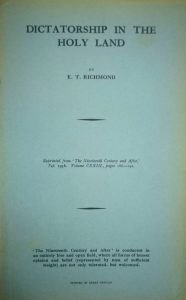
An offprint of one of Ernest Richmond’s articles, this one offering a strong criticism of the British Mandate and its mistreatment of the Arab population and their grievances. EUL MS 115/25
During the Second World War John Richmond served as an Army Intelligence Officer in Palestine, Syria and Iraq, where his knowledge of Arabic proved invaluable. At the end of July 1946 the Richmonds, with their two young twin daughters, moved to Jerusalem where John had obtained a post as Conservator of Ancient Monuments – with responsibility for the preservation of historic buildings – at the Palestine Museum where his father had worked. This was the time when the British Mandate in Palestine was coming to an end. According to the Balfour Declaration of 1917, Britain was committed to providing a ‘national home for the Jewish people’ in Palestine, but they had also made similar promises to the Arabs in return for military and political support during the First World War. The British were therefore faced with an impossible situation, unable to honour the promises they had made, and increasingly unable to maintain order as Zionist paramilitary groups took up arms to protest against the British refusal to admit Jewish immigrants. The murder of British soldiers, policemen and government officials became a regular occurrence, the most notorious incident being the blowing up of the King David Hotel in Jerusalem on 22 July 1946, with the death of over 90 people.
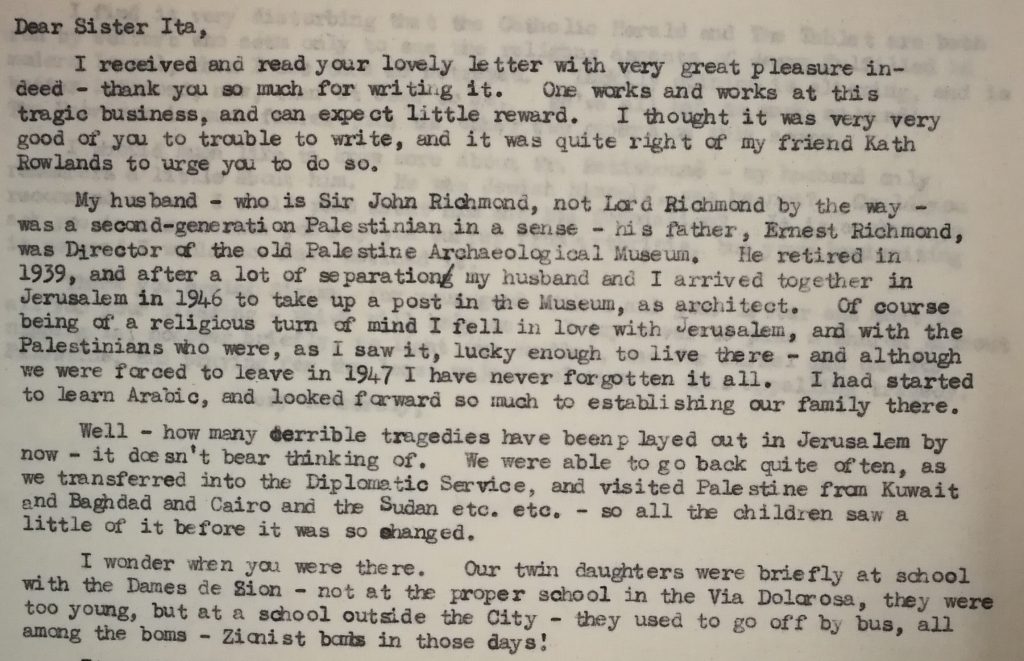
Excerpt from a letter from Diana Richmond to a nun from The Congregation of Our Lady of Sion, 14 July 1975. EUL MS 115/13/1
This occurred ten days before the Richmonds arrived in the city. As an Arabic speaker like his father, John Richmond developed friendships with local Palestinians and their daughters began attending a convent day school run by the Sisters of Our Lady of Zion at Katamon, just outside city. However, with the political situation growing increasingly unstable, it became clear that their hopes of settling in Jerusalem and raising their family here would be impossible. Less than a year after their arrival in Palestine, John Richmond was transferred to the British embassy in Baghdad. The British government announced in September 1947 that the Mandate for Palestine would end at midnight on 14 May 1948 and turned to the United Nations for help in finding a solution. After the UN General Assembly adopted a resolution recommending the adoption of the Partition Plan for Palestine, fighting broke out between Arab and Jewish communities. Over the next few months this would escalate into full-blown war, as the military forces of neighbouring Arab countries responded to the declaration of the new state of Israel on 15 May 1948.
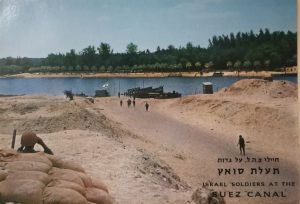
Postcard showing Israeli soldiers by the Suez Canal. EUL MS 115/8/13
During the Richmonds’ subsequent diplomatic postings they continued to visit Palestine and correspond with friends and colleagues in the region, as well as keeping themselves well-informed about developments in both the Arab and Israeli positions. It is fair to say, though, that their support for the Palestinians’ cause and their opposition to Zionism was rooted in the experiences described above, namely the influence of Ernest Richmond and their affection for the land and people they had known prior to 1947. In dozens of her letters, Diana Richmond referred back to her knowledge of this period and the Richmonds’ sense of having a ‘two generation link with Palestine and its peoples’. The strongly personal motives of their later activism gives the archive a fascinating resonance.
A large proportion of the papers relates to the Richmonds’ prolific correspondence with newspaper editors, journalists and representatives of the BBC concerning their coverage of the Middle East and – in particular – Israel’s occupation of Palestine. They monitored the media closely and were quick to challenge anything that they regarded as factual errors, suggestio falsi, biased omissions or misrepresentation. In the days before e-mails, these letters were usually drafted by hand and then typed up; more often than not, they received a personal response, ranging from apologies to defensive counter-arguments and – sometimes – an irritable backlash. Correspondents include William Rees-Mogg, Tom Burns (editor of The Tablet), Gerard Noel (editor of The Catholic Herald), Katy and Soraya Antonius, Dr Israel Shahak, Uri Davis, Dan Gillon, Solly Sachs, Cardinal Heenan, Bishop Ian Ramsey, Sir John Glubb, Norman St John Stevas, Fr. Thomas Corbishley SJ, Herbert McCabe OP, Fr. Henry Wansbrough OSB, Judith Maro, Michael Adams, Mgr. Bruce Kent (CND), Christopher Hollis, Christopher Walker, Stephen Spender, E.H. Gombrich, Bernard Palmer (editor of The Church Times), US Ambassador Kingman Brewster, Menahem Begin, Laurence Olivier, Mark Braham, Rev. Marcus Braybrooke, various diplomats and Foreign Office officials, as well as MPs such as Christopher Mayhew, Jo Grimond, Roy Jenkins and James Callaghan, Dennis Walters, Andrew Faulds, Jeremy Thorpe and PM Edward Heath.
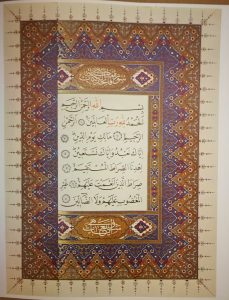
A page from the Koran, from a pamphlet in the Richmond collection. EUL MS 115/34
Their correspondence related not just to the media but to other activities such as CAABU work, public meetings and lectures, all of which were aimed at raising awareness of the situation in Palestine, encouraging dialogue between the different factions, and promoting a deeper understanding of Islam and the Arab world. Scholars interested in the development of contemporary Islamophobia might be interested in the Richmonds’ efforts to combat the ignorance and hostility shown towards Islam during this period, and what these papers reveal about the cultural positions and attitudes held by those in the media, political and religious circles. The Richmonds were also involved in supporting a range of charitable organisations and activities in the Middle East, such as the Spafford Children’s Hospital in Jerusalem, Musa Alami’s Arab Development Society, UNIPAL and the Friends of Bir Zeit University. They supported the inter-religious dialogue movement Jews-Christians-Muslims (JCM) as well as the British Algerian Society, the Anglo-Arab Association and a number of short-lived or lesser-known groups and publications active in these fields. They were particularly interested in human rights and collected a large amount of documentary material on conditions in the occupied territories, including reports from prisons and interrogation centres, and material on how the conflict affected Palestinian women and children.
Another significant strand that runs through the Richmond papers and remains of cutting relevance today is the debate over the boundaries between anti-Zionism and anti-Semitism, particularly in the political sphere where critics of Israeli policy and supporters of the Palestinian cause have often been accused of holding anti-Semitic views. The Richmonds tried to adhere to a definition of Zionism as ‘the political movement arising out of Theodor Herzl’s book, Der Judenstaat, and finding its political expression in part through the series of Zionist congresses’, and were keen to emphasise that their use of the terms ‘pro-’ or ‘anti-Zionist’ could only ever be a political judgment, based on exclusively political criteria. They corresponded with a number of Jewish writers and campaigners, including several non-Zionist Jews, and were at pains to develop a more nuanced debate about the distinctions between sympathy for the Israeli people and criticism of the injustices brought about by Israeli government policy. Unfortunately, they also attracted interest from individuals and organisations who were genuinely anti-Semitic, such as the eccentric but deeply unpleasant National Cleansing Crusade. Anyone with such views received short shrift from the Richmonds, with their communications either unanswered or dismissed with a terse postcard reply, and any material they sent placed in sealed envelopes marked ‘Anti-Semitic Filth.’
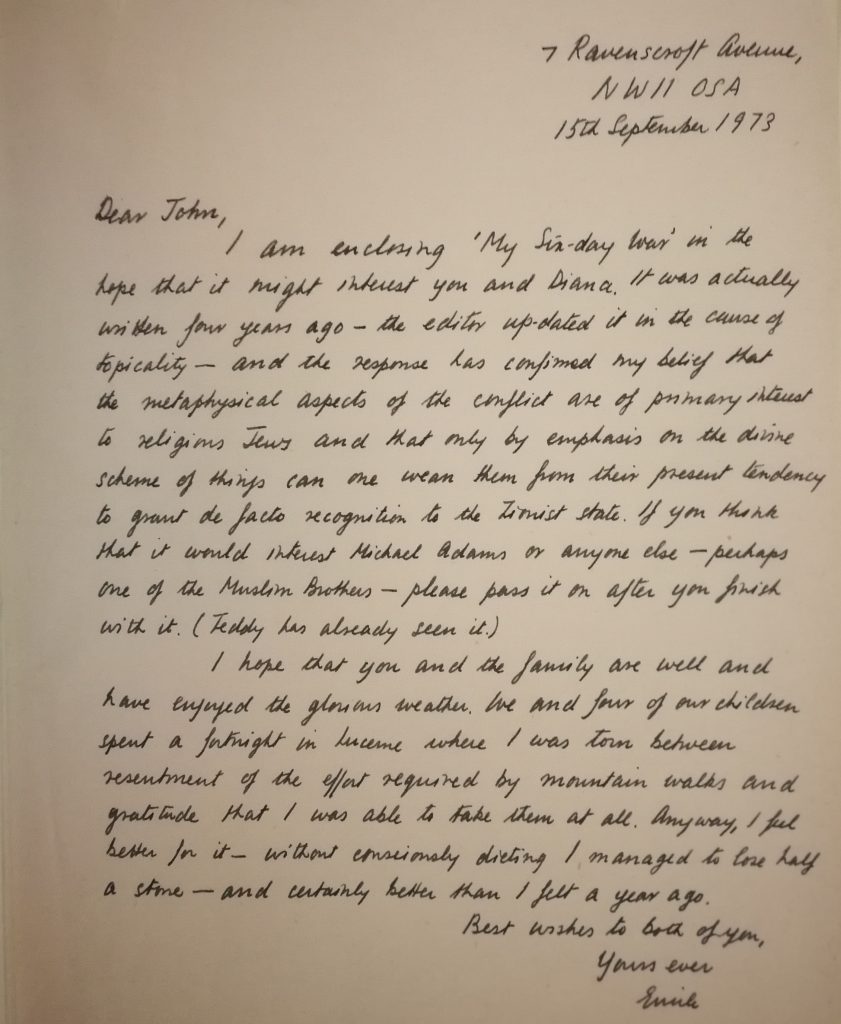
A letter from Emile Marmorstein to John Richmond. EUL MS 115/5/12
In addition to the correspondence and writings of the Richmonds themselves – the latter of which include typed articles, talks, memoirs, translations and verse – the collection holds a large amount of secondary material relating to the history of Palestine and political activism, from the 1920s through to the 1980s. These include scholarly papers and offprints from academic journals, as well as a wide selection of more radical publications such as home-made ‘zines’ and student papers that reflect the artwork and graphic design of the underground counter-culture of the 1960s and 1970s: a reminder that the Richmonds’ daughter Sophie worked as secretary for the Sex Pistols and helped design some of their iconic artwork.
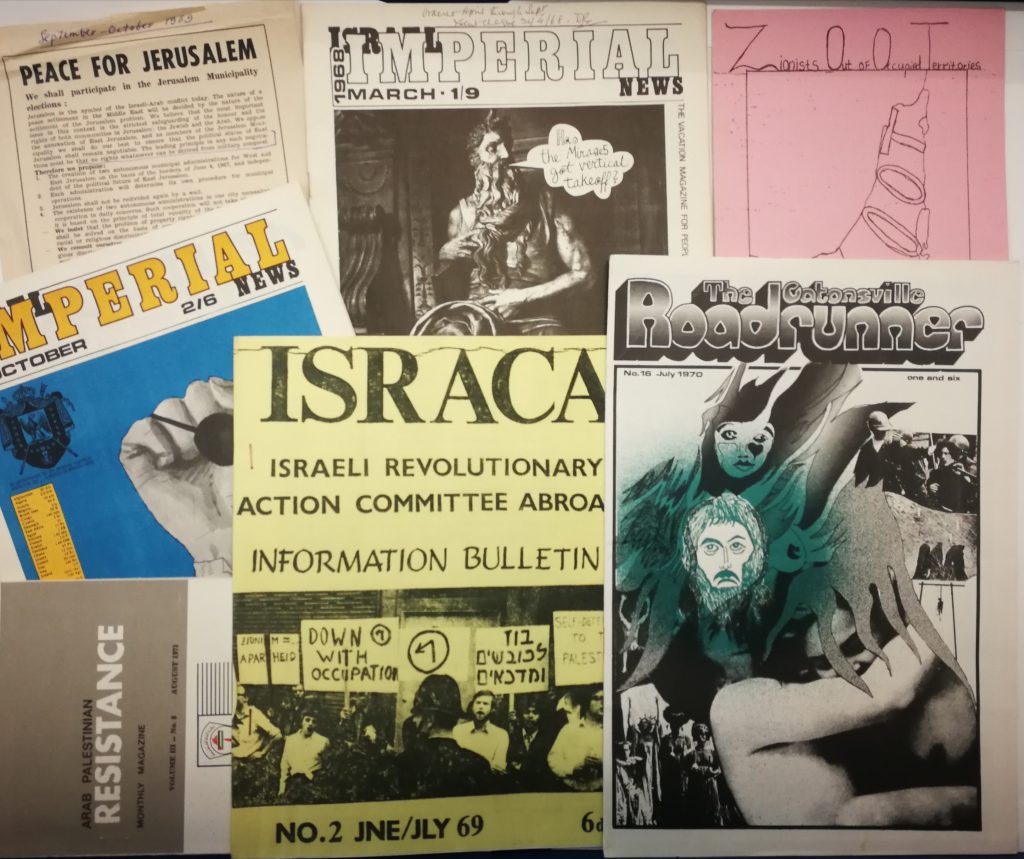
Just some of the wide range of periodicals and pamphlets and other literature held in the Richmond collection
It is sometimes forgotten now that pro-Palestinian activism in Britain was not a phenomenon that took off in the 1980s, but it actually had a much longer tradition. An examination of the Richmond papers will help researchers gain a better understanding of these activities and their place within the literary, religious and political culture of late 20th century Britain.
The online catalogue of the Richmond papers can be explored here.